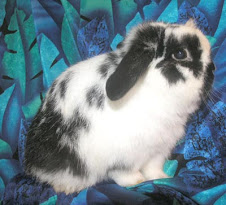
We were pleased a couple of weeks ago to rescue a newborn Holland and return him to his nestbox. Sadly, he was the only one of his litter who survived.... and that didn't turn out so well.
I've had some breeders tell me that it's impossible to save single babies because they don't have litter mates to keep them warm. Well, we haven't really had problems with that. If I put a reflector lamp (like the one pictured in this post) with a 75-watt light bulb on top of the cage, focusing the heat of the light bulb on the baby, it usually survives nicely.
(Please be very careful using a reflector lamp. It must be well secured or it could start a fire.)
And the little rescued Holland did fine under the light. However, another problem arose. We've had it before but not this bad and we decided this time to figure out how to handle it.
The mother of this little baby is a fine mama with lots of milk. Way too much milk for one baby. But the little baby, alternately known as Piggy and Tubbo, has engorged himself on milk.
That fat little tummy of his pressed his back legs to the side so that now, at 2 weeks of age, he has permanently splayed legs. Because it's warm enough in the rabbit barn, we took him out of his nestbox early and put a piece of carpet in his cage to help him get more exercise.
We hoped once he lost that big belly, the legs would pull back in line. They haven't.
After talking with some other breeders, here's what we'll do the next time we have a single:
1. Leave the nestbox with the mama for the first couple of days, until she gets used to caring fo the baby.
2. Then pull the nestbox out of the cage, placing it in a safe place (as from cats or other predators) with a light on it for heat.
3. Return the nestbox to the mother once a day. Watch until she's fed the baby, then pull the nestbox out again.
Hopefully, this will prevent another occurrence of moose-itis in a single baby.











